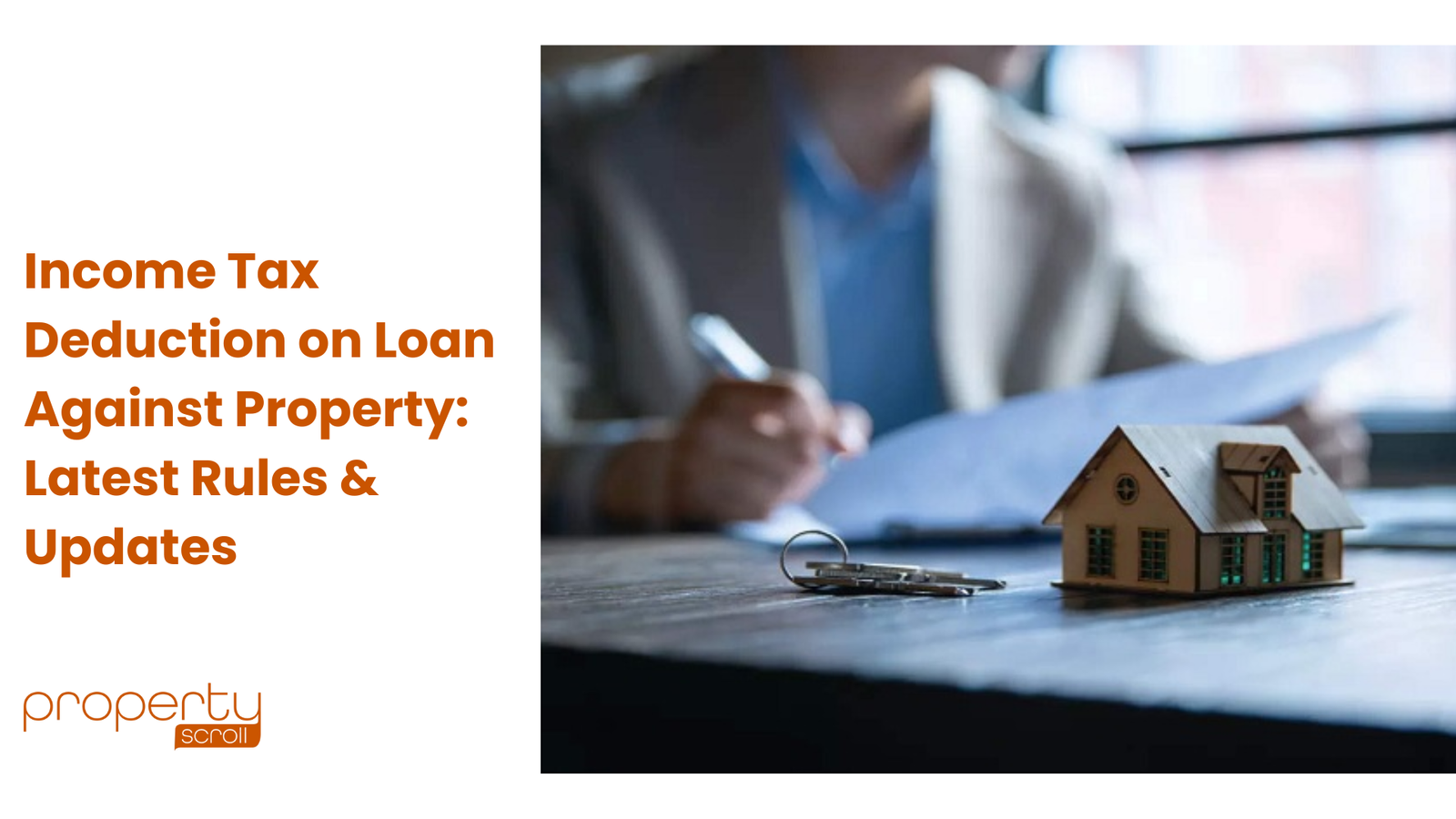In India, taking a loan against property (LAP) can be a powerful financial tool—not just to unlock liquidity but also potentially to reduce your taxable income. However, the tax benefits depend heavily on how you use the loan and which sections of the Income Tax Act apply. With recent updates in tax laws, it’s critical to stay informed. In this guide, we explain the latest rules, eligibility, and how deductions work—especially in the context of buying or financing 3 BHK flats via an online property portal or other channels.
What Is a Loan Against Property & Its Uses?
A loan against property allows you to borrow money by mortgaging a residential or commercial property you already own (or sometimes property under construction). Unlike home loans, LAP funds can be used for diversified purposes—business expansion, debt consolidation, education, or even buying another property such as a 3 BHK flat listed on an online property portal.
But unlike a home or construction loan strictly for acquiring property, not all parts of a LAP are eligible for tax deduction. The purpose and end-use matter a lot.
Key Sections & Latest Updates
Section 24(b) — Interest Deduction for House Property
- Under Section 24(b), interest paid on borrowed capital for a property can be deducted when computing “Income from House Property.”
- For a self‑occupied property, the deduction is capped at ₹2,00,000 per year (or lower if interest is lower).
- For a let-out or vacant property, the entire interest paid can be deducted (i.e., there is no upper limit) when calculating income from house property.
- Pre-construction interest (interest paid during the construction period) must be accumulated and claimed in five equal installments starting from the year of completion.
Latest change: The newer Income Tax Bill proposed clarifications allowing deduction of home loan interest even for let-out properties and reaffirming the 30% standard deduction from Net Annual Value (NAV) after municipal taxes.
Section 80C — Principal Repayment & Other Deductions
- The principal portion of loan repayment (and associated stamp duty/registration fees) qualifies for deduction under Section 80C, subject to the overall cap of ₹1,50,000 per year.
- This is allowed only if the loan is for purchase or construction of the property—not for repairs, renovation, or LAP for other purposes.
- Under the new tax regime, many of these deductions (including 80C for principal repayments) may not be allowed.
Section 80EE & 80EEA — Additional Interest Deductions
- Section 80EE: For very specific earlier periods, first-time homebuyers could claim an extra ₹50,000 interest deduction, subject to strict conditions
- Section 80EEA, aimed at affordable housing, allows you to deduct up to ₹1,50,000 in interest (over and above Section 24) if you meet conditions like property value under ₹45 lakh, loan sanctioned between 1 Apr 2019 and 31 Mar 2022, first home, and more.
- These extra sections are relevant only under the old tax regime. They are not available under the new tax regime.
Section 37(1) — Business Use of Loan Funds
- If you use the LAP funds for business purposes, interest and related charges (processing fees, documentation costs) may be deductible under Section 37(1) as business expenses.
- But you can claim this only when you demonstrably use the funds for business. If you use the loan for personal purposes (weddings, vacations, etc.), you cannot claim such deductions.
How These Rules Interact with LAP?
Because LAP is not always strictly for property purchase or construction, you must segregate the portion used for housing vs the remainder. Only the portion used for property-related purposes may qualify under Sections 24 and 80C. The rest, if used for business, may fall under Section 37(1).
Moreover, if you buy a 3 BHK flat using a mix of LAP and home loan or pure LAP, then that part of the loan financing the flat’s cost might be eligible under these sections (assuming you satisfy all conditions).
Choosing Between the Old & New Tax Regime
Since FY 2023-24, the new tax regime is often the default choice. But many deductions available under the old regime—especially interest and principal deductions—are not available in the new regime (for self-occupied properties).
However, under the new regime, for a let-out/ rented property, you may claim interest deduction without ceiling under 24(b).
You must run both regimes (old vs new) with your income and see which gives you a lower tax burden, particularly considering the property and loan structure.
Latest Updates & Proposed Amendments
- The Income Tax Bill 2025 introduced two key clarifications: (1) explicit allowance of interest deduction for let-out properties, and (2) reaffirmation of 30% standard deduction from net annual value after municipal taxes.
- These changes aim to reduce ambiguity around deductions in rental property taxation.
- Also, for FY 2025-26, taxpayers under the old regime must include more details and disclosures when claiming exemptions/deductions.
Always check whether these changes are enacted on ground (after rules and clarifications) before relying wholly.
Example: How This Might Work for a Buyer Using an Online Property Portal to Buy a 3 BHK Flat
Let’s assume:
- You find a 3 BHK flat on an online property portal and decide to buy it via a mix of home loan + LAP.
- Of the total loan, ₹50 lakh is to purchase the flat; another ₹10 lakh is used for business expansion.
- For the ₹50 lakh portion, you can apply Sections 24(b) and 80C (if under old regime) for interest and principal deduction.
- For the ₹10 lakh portion used in business, you may apply Section 37(1) to deduct the interest (if properly documented).
- If you rent out this 3 BHK flat, the interest portion is fully deductible (no cap) when computing income from house property, irrespective of your tax regime choice (new or old).
This split approach ensures that you maximize eligible tax benefits while maintaining compliance.
Key Conditions & Common Pitfalls
- Purpose & Proof
Always ensure the portion claimed under Sections 24 or 80C is used for property. Keep bank statements, loan accounts, and usage records. - Property Completion / Possession
For under-construction properties, interest till possession is accumulated and claimed later over five years. - Minimum Ownership Period
If you sell the property within 5 years of possession, deductions claimed may be reversed into taxable income. - New Regime Restrictions
Many deductions (like 80C, 80EE, 80EEA) are unavailable under the new regime, especially for self-occupied properties. - Loss Set-off Rules
For let-out properties, if interest exceeds rent causing a loss from house property, you can set off up to ₹2 lakh against other income under the old regime. Carry forward the excess (for 8 years) to set off only against house property income. Under the new regime, you cannot set off loss from house property against other income heads. - Co-Borrowers / Co-Owners
If property or loan is in joint names, deductions must usually be declared by each owner proportionally (unless special provisions). - Documentation & Disclosures
With newer ITR utilities, you must provide more detailed proofs of property ownership, loan documents, interest certificates, and more.

To Sum Up
- Loans against property can offer tax advantages, especially when used for 3 BHK flats or other residential property investments.
- Section 24(b) allows deduction of interest (₹2 lakh limit for self-occupied; unlimited for let-out).
- Section 80C enables principal repayment deduction (only under old regime).
- Sections 80EE / 80EEA provide additional interest deductions for first-time or affordable homebuyers (strict conditions).
- Section 37(1) allows deductions for business use of loan funds.
- Under the new tax regime, many deductions for self-occupied property are lost, but interest deduction for let-out property remains allowed.
- Recent legislative proposals seek to clarify and strengthen these deductions further—especially for rental properties.
Before making decisions, always run your own tax projections under both regimes, maintain proper documentation, and consult a qualified tax advisor for your specific situation.



